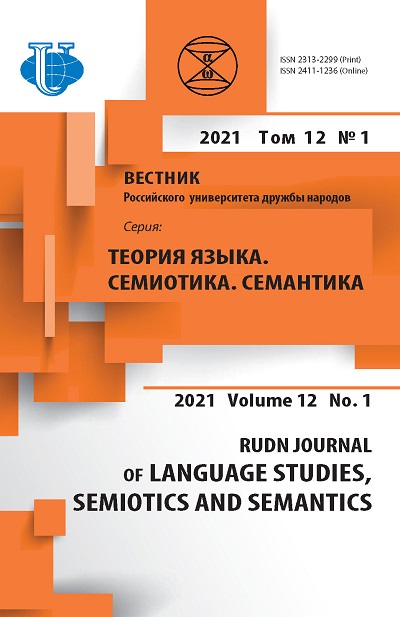Linguocognitive Specifics of the Disease Myth
- Authors: Stepanova E.S.1
-
Affiliations:
- Samara State Medical University
- Issue: Vol 12, No 1 (2021)
- Pages: 153-164
- Section: SEMIOTIC AND POETIC TEXT STUDIES
- URL: https://journals.rudn.ru/semiotics-semantics/article/view/25811
- DOI: https://doi.org/10.22363/2313-2299-2021-12-1-153-164
- ID: 25811
Cite item
Full Text
Abstract
The article deals with the question of cancer myth representation in the popular science medical discourse. This study is carried out according to the linguocultural approach to the study of the cancer myth, which is based on the reconsideration of linguocultural phenomena. Myths about diseases are of linguistic and cultural significance and they are passed down from generation to generation. Those of phenomena that are incomprehensible and frightening are considered to cause additional associations. Cancer diseases refer to such linguocultural phenomena. Myths about diseases reflect the results of this or that form of reconsideration or experience of some phenomena by a particular linguocultural society. The work provides the definitions of the notions “myth” and “disease”. The methodology of the study is based on the research by foreign and Russian scientists in the field of study of the notions of “myth” and “disease” as semiotic systems. The popular science medical survey “The Emperor of All Maladies: A Biography of Cancer” by Siddhartha Mukherjee served as a research background. It analyses the way the disease myth actualizes in the popular science medical discourse. It shows a mythological plot (or mythological information) to get actualized in a particular situation by means of reference, and the way it contributes to the explication of a particular disease myth. Neither the subject of the message nor the plot of the myth is of importance for the reader, only the influence of the myth on the patient’s representations of disorder and his emotional state and on the society as a whole makes sense. The study helps conclude that mythological information representing the disease myth is nationally and socially marked, and is characterized by a particular conceptual presentation and is expressed by different linguistic means.
Full Text
Fig.1. Intertextual means of disease myth representation on the example of the work “The Emperor of All Maladies: A Biography of Cancer” by Siddhartha Mukherjee
About the authors
Elena S. Stepanova
Samara State Medical University
Author for correspondence.
Email: pretty.step@bk.ru
PhD of Philology, Department of Foreign and Latin Languages
89, Chapaevskaya str., Samara, Russian Federation, 443099References
- Tkhostov, А.Sh. & Nelyubina, A.S. (2009). Сorrelation of rational and irrational in ordinary consciousness on example of beliefs about diseases. Moscow University Psychology Bulletin, 1, 32—38. (In Russ.).
- Thostov, A.Sh. (2002). Philosophy of Corporeality. Moscow: Publishing house “Smysl”. (In Russ.).
- Losev, A.F. (1983). Sign. Symbol. Myth. Moscow: Moscow State University. (In Russ.).
- Cassirer, E. (2002). Philosophie der Symbolischen Formen. Vol. 1. Language. Moscow, Saint Petersburg: Publishing house “Universitetskaya kniga”. (In Russ.).
- Potebnya, A.A. (1989). A Word and a Myth. Moscow: Publishing house “Pravda. (In Russ.).
- Lévi-Strauss, C. (1985). Anthropologie structural (transl. from French by V.V. Ivanov). Moscow: Publishing house “Nauka”. (In Russ.).
- Eliade, M. (1996). Aspects du Mythe. Trans. from French. Moscow: Publishing house “Academia”. (In Russ.).
- Brokgauz, F.A. & Efron, I.A. (2002). Encyclopaedic Dictionary. Moscow: Publishing house “Ehksmo”. (In Russ.).
- Stepanova, E.S. (2020). Linguocognitive specifics of a doctor’s myth. Vestnik of the Mari State University, 14(3), 379−385. doi: 10.30914/2072-6783-2020-14-3-379-385. (In Russ.).
- Ozhegov, S.I. (1987). Dictionary of the Russian Language. Moscow: Publishing house “Russian Language”. (In Russ.).
- Tuleninova, L.V. (2006). Metaphor as a way of expression of the concept “disease” (on the material of the English and Russian languages). Linguistic and literary studies in synchronic and diachronic aspects, 1, 515—517. (In Russ.).
- Mukherjee, S. (2010). The Emperor of All Maladies: A Biography of Cancer. New York: Scribner. (In Eng.).
- Lotman, Yu.M. (1999). Inside Thinking Worlds: Man — Text — Semiosphere — History. Moscow: Publishing house “Russian Culture Languages”. (In Russ.).
- Ivanov, V.V. & Toporov, V.N. (1974). Research in the Field of Slavic Antiquity. Lexical and Phraseological Questions of Text Reconstruction. Moscow: Publishing house “Nauka”. (In Russ.).
- Segal, D.M. (1962). About Some Problems of Semiotic Study of Mythology. In Symposium on Structural Study of Language Systems. Moscow: Publishing house “USSR Academy of Sciences”. 92—98. (In Russ.).
- Saussure, F. de. (2001). Cours de Linguistique générale. Trans. from French. Moscow: Publishing house “Progress”. (In Russ.).
- Bart, R. (1994). Myth Today. In Collected Works: Semiotics. Theory of Poetry. Moscow: Publishing house “Progress”. (In Russ.).
- Vladimirova, T.Eu. (2020). Semantic Continuum of Myth. RUDN Journal of Language Studies, Semiotics and Semantics, 11(2), 161—174. doi: 10.22363/2313-2299-2020-11-2-161174.
Supplementary files












